Robotic technology has become integrated into a range of different fields, including orthopedic surgery. An article published in the journal BMC Musculoskeletal Disorders has analyzed the trends of robotic orthopedic surgeries in a clinical setting employing bibliometrics.

Image Credit: Gorodenkoff/Shutterstock.com
Orthopedic techniques continue to evolve at a rapid pace, even more so following the technological explosion of robotic surgery, deep learning approaches, 3D printing, and virtual reality.
Robotic technology use in the medical sector continues to rise, and many surgical robots have obtained approval for clinical practice in the USA from the Food and Drug Administration. There are also reports that robotic surgery is highly precise in orthopedic implant placement. However, orthopedic robotics remains a challenging and complex technique.
Bibliometrics is a research technique commonly utilized to investigate the characteristics and development of a subject area. Until now, there is no comprehensive analysis of the clinical study of orthopedic robots by bibliometric analysis.
Here, the researchers aim to use bibliometric analysis to identify the features in robotic orthopedic surgery, including study design, kind of surgery, robot information and country of use.
The team also set out to complete data visualization to explore the relationship between various institutions, journals, countries and investigate research hotspots and trends.
Methodology
The electronic database, Web of Science, was explored between 2000 and 2019 (no language restrictions) using the search for various keywords. The search results and the cited literature were reviewed.
Inclusion criteria depended on the article elaborating clinical research on the application of robotic surgery in orthopedics and review article, clinical trial, meta-analysis, and guideline. Book chapters, animal studies, conference proceedings, and cadaveric investigations were included under exclusion criteria.
The information was exported from the WoS, summarized, and examined with the WPS office. The widely employed approach of coupling, co-citation, co-occurrence analysis was carried out.
Results
A total of 1013 primary research results, 186 publications, and 1124 cited papers were reviewed and 224 clinically-related publications were selected for bibliometric analysis.
The selected publications comprised 164 articles, 47 reviews, and 13 meta-analyses. Figure 1 shows the complete global contribution of publications from 2000 to 2019.
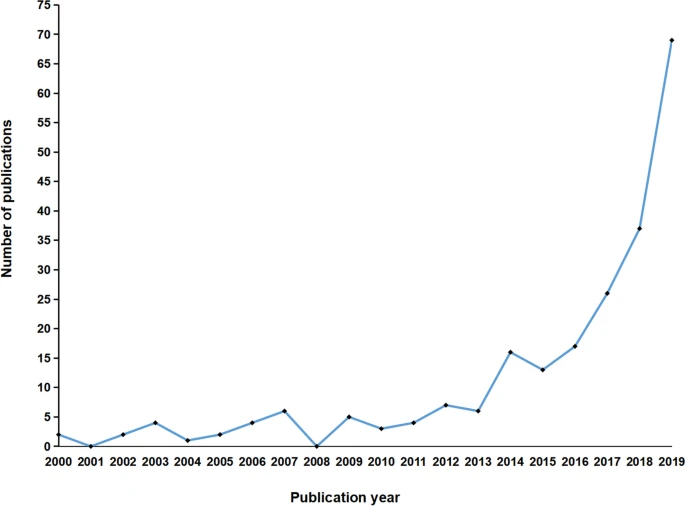
Figure 1. Graphs indicating the total annual number of global contributions. Image Credit: Li, et al., 2021
The articles were from 23 countries (see Figure 2).

Figure 2. Global distribution according to country. Image Credit: Li, et al., 2021
During 2018 and 2019, major contributions were from the United States, China, and the United Kingdom (see Figure 3).
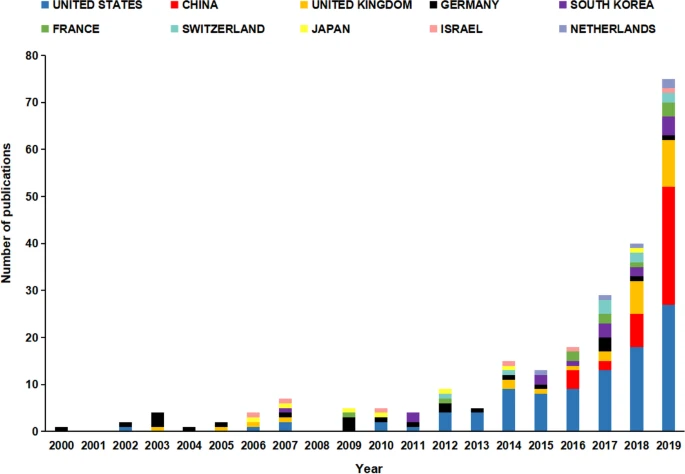
Figure 3. Annual contributions according to country. Image Credit: Li, et al., 2021
The minimum number of publications from a country was set to two publications with 17 countries meeting the criteria (see Figure 4).

Figure 4. Coupling analysis of countries on global robotic orthopedic surgery research. Image Credit: Li, et al., 2021
Table 1 lists the institutions with at least eight publications.
Table 1. Global institutions with at least eight publications on orthopedic robotic surgery. Source: Li, et al., 2021
| Institutions |
Number of
articles |
Country |
H-index |
Sum of
Times
Cited |
Average
citations
per item |
| Beijing Jishuitan Hospital |
15 |
China |
5 |
97 |
6.47 |
| Cleveland Clinic |
13 |
USA |
7 |
145 |
11.15 |
| University of London |
13 |
UK |
7 |
140 |
10.77 |
| Hospital for Special Surgery |
10 |
USA |
7 |
178 |
17.8 |
| Northwell Health |
8 |
USA |
4 |
33 |
4.13 |
| University of Göttingen |
8 |
Germany |
7 |
404 |
50.5 |
Coupling analysis indicated the top three institutions with the highest total link strengths (see Figure 5).
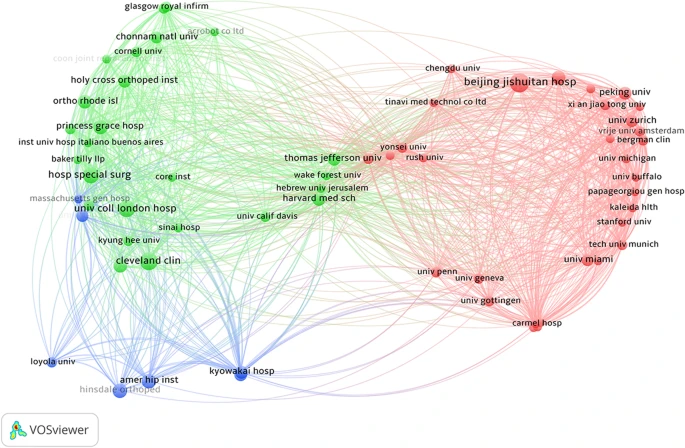
Figure 5. Coupling analysis of institutions on robotic orthopedic surgery. Image Credit: Li, et al., 2021
Table 2 enlists the top nine authors who according to the number of publications.
Table 2. The top nine authors in the orthopedic robotic surgery field ranked according to the number of publications. Source: Li, et al., 2021
Author
name |
Number of
article |
Country |
Institution |
H-index |
Sum of
times
cited |
Average
citations
per item |
Mont,
Michael A |
14 |
USA |
Cleveland
Clinic |
7 |
115 |
8.21 |
Tian,
Wei |
14 |
China |
Beijing Jishuitan
Hospital |
5 |
84 |
6 |
Domb,
Benjamin G |
10 |
USA |
Hinsdale
Orthopaedics |
6 |
153 |
15.3 |
Liu,
Ya-Jun |
10 |
China |
Beijing Jishuitan
Hospital |
5 |
59 |
5.9 |
Haddad,
Fares S |
9 |
UK |
University of
London |
5 |
91 |
10.11 |
Khlopas,
Anton |
9 |
USA |
Cleveland
Clinic |
6 |
83 |
9.22 |
Konan,
Sujith |
9 |
UK |
University of
London |
5 |
88 |
9.78 |
Sodhi,
Nipun |
9 |
USA |
Cleveland
Clinic |
6 |
81 |
9 |
Kayani,
Babar |
9 |
UK |
University of
London |
5 |
91 |
10.11 |
Analyzing the top 30 most cited papers Spine had the highest number of publications with five papers. It was noted that 69 journals published the use of robotics in orthopedic surgery (see Table 3).
Table 3. Journals with at least six publications in orthopedic robotic surgery. Source: Li, et al., 2021
| Journals |
Total
publications |
Total
cites |
Average citations
per item |
| Journal of Arthroplasty |
27 |
238 |
8.81 |
| Spine |
13 |
212 |
16.31 |
International Journal of Medical Robotics
and Computer Assisted Surgery |
13 |
78 |
6 |
| Orthopaedic Surgery |
13 |
15 |
1.15 |
| World Neurosurgery |
10 |
26 |
2.6 |
| Knee Surgery, Sports Traumatology, Arthroscopy |
9 |
62 |
6.89 |
| Journal of Knee Surgery |
9 |
30 |
3.33 |
| Neurosurgical Focus |
7 |
48 |
6.86 |
| Bone & Joint Journal |
7 |
18 |
2.57 |
| Clinical Orthopaedics and Related Research |
6 |
104 |
17.33 |
| European Spine Journal |
6 |
108 |
18 |
| Expert Review of Medical Devices |
6 |
20 |
3.33 |
| Knee |
6 |
54 |
9 |
Table 4 shows the top 10 journals on orthopedic robotic surgery based on the impact factor.
Table 4. Top 10 journals on orthopedic robotic surgery ranked according to impact factor. Source: Li, et al., 2021
| Journals |
Impact factor (2018) |
Total publications |
| Sports Medicine |
7.583 |
1 |
| Journal of Bone and Joint Surgery-American Volume |
4.716 |
4 |
| Neurosurgery |
4.605 |
4 |
| Bone & Joint Journal |
4.301 |
7 |
| Clinical Orthopaedics and Related Research |
4.154 |
6 |
| Scientific Reports |
4.011 |
1 |
| Plastic and Reconstructive Surgery |
3.946 |
1 |
| Annals of Translational Medicine |
3.689 |
3 |
| Bone & Joint Research |
3.652 |
1 |
| Haemophilia |
3.59 |
1 |
The minimum number of publications of a journal was then set to two papers and coupling analysis of 32 journals was carried out (Figure 6).

Figure 6. Coupling analysis of journals on robotic orthopedic surgery. Image Credit: Li, et al., 2021
Then the minimum number of publications of a journal was set to at least 30 citations and co-citation analysis of the 30 journals was carried out (see Figure 7).
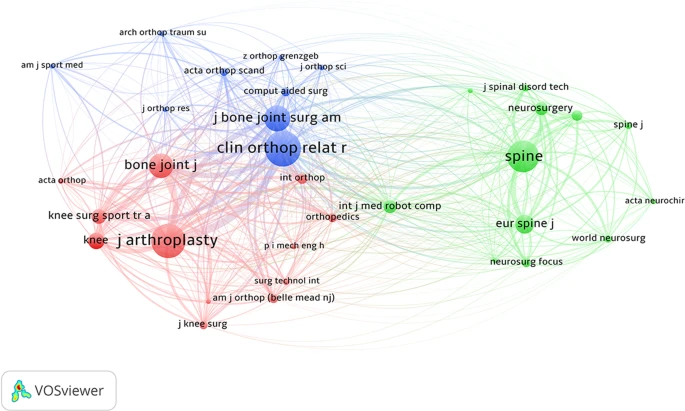
Figure 7. Co-citation analysis of journals on robotic orthopedic surgery. Image Credit: Li, et al., 2021
Around 152 studies detailed the kind of robot and surgical information and the most common surgical sites were the knee, spine, and hip. It was also noted that pedicle screw implantation was performed mostly (see Table 5).
Table 5. Type of robotic orthopedic surgery and the surgical site. Source: Li, et al., 2021
| Surgical site |
Type of procedure |
n (%) |
| Spine |
Pedicle screw implantation |
56 (89%) |
| Vertebral augmentation |
3 (5%) |
| Laparoscopic anterior lumbar interbody fusion |
1 (1%) |
| Spine tumor resection surgery |
1 (1%) |
| Intraoperative localization |
1 (1%) |
| Anterior lumbar interbody fusion |
1 (1%) |
| Knee |
Total knee arthroplasty |
24 (50%) |
| Unicompartmental Knee Arthroplasty |
23 (48%) |
| Anterior cruciate ligament reconstruction |
1 (2%) |
| Hip |
Total hip arthroplasty |
30 (100%) |
| Femur |
Femoral neck cannulated screw placement |
3 (60%) |
| Intramedullary nail fixation |
1 (20%) |
| Core decompression of the femoral head |
1 (20%) |
| Pelvis |
Internal fixation of pelvic acetabular injuries |
1 (25%) |
Percutaneous cannulated screw fixation, INFIX fixation,
open reduction and internal plate fixation |
1 (25%) |
| Percutaneous screw placement combined with INFIX |
1 (25%) |
| Neurolysis |
1 (25%) |
| Hand |
Percutaneous internal fixation |
1 (100%) |
| Elbow |
Oberlin procedure |
1 (100%) |
It was noted that 14 types of orthopedic robots were employed and the most diverse were utilized in the knee and spine. The widely used one was TiRobot, succeeded by DA Vinci (see Figure 8).
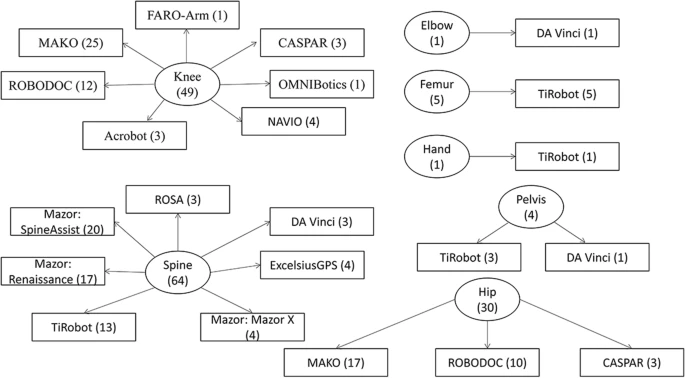
Figure 8. Types of robots in orthopedic surgery and corresponding surgical sites. Image Credit: Li, et al., 2021
Six countries developed 14 kinds of surgical robots, with more than half originating from the United States (see Figure 9).
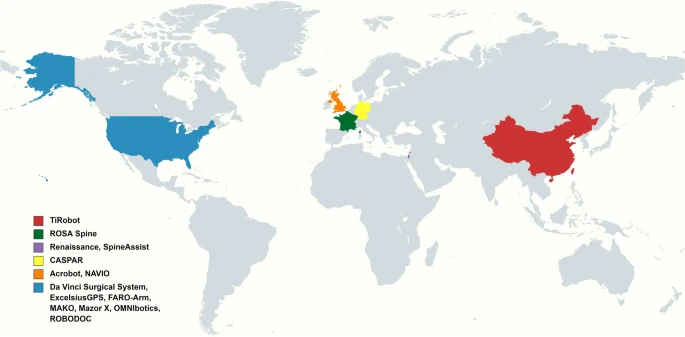
Figure 9. Six countries produce robots for orthopedic use. Image Credit: Li, et al., 2021
The study exported 950 author keywords from the included studies. Table 6 lists the most frequently used 20 keywords.
Table 6. Top 20 most frequently used keywords in robotic orthopedic surgery publications. Source: Li, et al., 2021
| Keywords |
Number of occurrences |
| Robotics |
43 |
| Pedicle screw |
33 |
| Total knee arthroplasty |
30 |
| Unicompartmental knee arthroplasty |
27 |
| Navigation |
25 |
| Outcome |
24 |
| Spinal fusion |
24 |
| Robotic surgery |
21 |
| Minimally invasive |
20 |
| Total hip arthroplasty |
17 |
| Computer-assisted surgery |
17 |
| Accuracy |
16 |
| Arthroplasty |
14 |
| ROBODOC |
9 |
| MAKO |
9 |
| Learning curve |
8 |
| Complication |
7 |
| Freehand technique |
7 |
| TKA |
7 |
| Mazor |
6 |
All keywords were examined by VOSviewer software. The red-colored group in Figure 10 was associated with robotic surgery in joint replacement and the green-colored group was linked to spinal surgery.
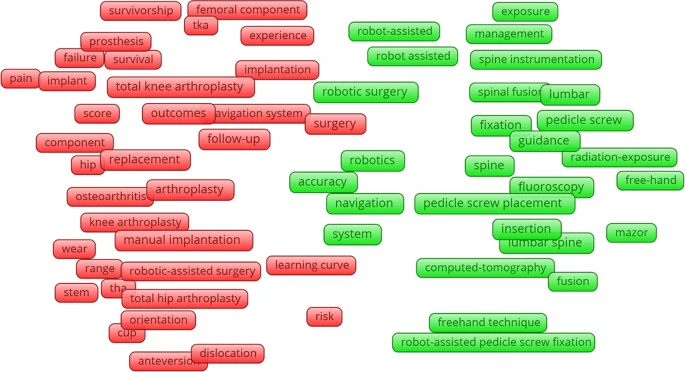
Figure 10. Co-occurrence network of robotic orthopedic surgery. Image Credit: Li, et al., 2021
Figure 11 shows the overlay visualization between 2000 and 2019 in robotic orthopedic surgery.
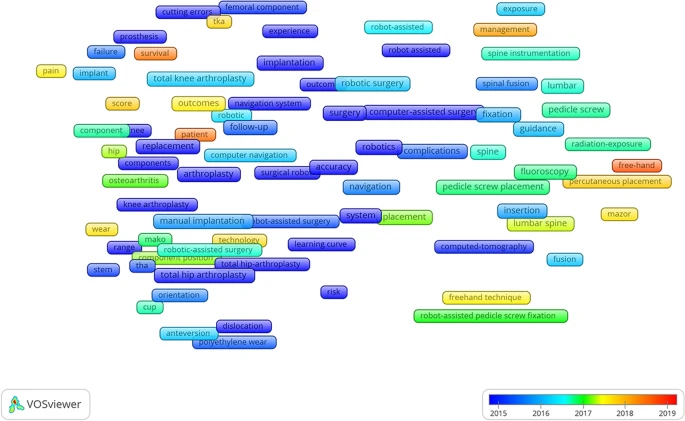
Figure 11. Overlay visualization from 2000–2019 in robotic orthopedic surgery. Image Credit: Li, et al., 2021
Discussion
This research identified 224 related papers in the 2000 to 2019 timespan. Bibliometric analysis analyzed the characteristics of the robotic technique in orthopedics.
The bibliometric analysis showed an increasing trend in the global contributions from 2000 to 2019. Most numbers of relevant publications were from the United States, and currently, only 23 countries are involved in orthopedic robot research.
It is likely that the lack of competition may create market monopolies.
It was noted that the authors Tian Wei and Mont Michael A made the majority of the contributions in the orthopedic robot field. Bibliographic coupling networks of institutions revealed that most institutions were from the United States.
Research from the Cleveland Clinic was found to be the most relevant, followed by Beijing Jishuitan Hospital and the University of London.
Bibliographic coupling and co-citation network of the journal showed that the Journal of Arthroplasty was the most influential and relevant in the orthopedic robot field. MAKO and Mazor were the most widely used orthopedic robot in spine and lower limb joint surgery.
Limitations
The bibliometric analysis missed numerous publications from databases like PubMed and Scopus.
Citation time may also have been affected by the time sequence of publications, self-citation, and controversial articles. The study also did not consider publications involving cadaveric or animal studies.
Conclusion
Robotic technology in clinical orthopedics is an emerging field, and many researchers and institutions will play a vital role in broadening its use.
Fracture fixation, in particular, is a hopeful application for further development in robotic trauma surgery.
Robotic Microswimmers: The Next Biomedical Breakthrough.
Journal Reference:
Li, C., Wang, L., Perka, C., Trampuz, A. (2021) Clinical application of robotic orthopedic surgery: a bibliometric study. BMC Musculoskeletal Disorders, 22, p. 968. Available online: https://bmcmusculoskeletdisord.biomedcentral.com/articles/10.1186/s12891-021-04714-7#citeas.
References and Further Reading
- Olczak, J., et al. (2017) Artificial intelligence for analyzing orthopedic trauma radiographs: deep learning algorithms—are they on par with humans for diagnosing fractures? Acta Orthopaedica, 88. pp. 581–586. doi.org/10.1080%2F17453674.2017.1344459.
- Bi, B., et al. (2019) The effect of robot-navigation-assisted core decompression on early stage osteonecrosis of the femoral head. Journal of Orthopaedic Surgery and Research, 14, p. 375. doi.org/10.1186/s13018-019-1437-x.
- Lohre, R., et al. (2020) The evolution of virtual reality in shoulder and elbow surgery. JSES International, (4), pp. 215–423. doi.org/10.1016/j.jseint.2020.02.005.
- Dong, X.-P., et al. (2020) Three-dimensional printing for the accurate orthopedics: clinical cases analysis, 3, pp. 122–132. doi.org/10.1007/s42242-020-00070-y.
- D’Souza, M., et al. (2019) Robotic-Assisted Spine Surgery: History, Efficacy, Cost and Future Trends. Journal of Robotic Surgery, 6, pp. 9–23. doi.org/10.2147%2FRSRR.S190720.
- Nakamura N., et al. (2010) A comparison between robotic-assisted and manual implantation of cementless total hip arthroplasty. Clinical Orthopaedics and Related Research, 468, pp. 1072–1081. doi.org/10.1007/s11999-009-1158-2.
- Kalavrytinos, D., et al. (2020) Expanding Robotic Arm-Assisted Knee Surgery: The First Attempt to Use the System for Knee Revision Arthroplasty. Case Reports in Orthopedics, 2020, p. 4806987. doi.org/10.1155/2020/4806987.
- Wu, X.-B., et al. (2019) Guidance for the Treatment of Femoral Neck Fracture with Precise Minimally Invasive Internal Fixation Based on the Orthopaedic Surgery Robot Positioning System. Orthopaedic Surgery, 11, pp. 335–340. doi.org/10.1111/os.12451.
- Bargar, W. L., et al. (2018) Fourteen Year Follow-Up of Randomized Clinical Trials of Active Robotic-Assisted Total Hip Arthroplasty. Journal of Arthroplasty, 33, pp. 810–814. doi.org/10.1016/j.arth.2017.09.066.
- Song, E.-K., et al. (2011) Simultaneous bilateral total knee arthroplasty with robotic and conventional techniques: a prospective, randomized study. Knee Surgery, Sports Traumatology, Arthroscopy, 19, pp. 1069–1076. doi.org/10.1007/s00167-011-1400-9.
- Kantelhardt, S.-R., et al. (2011) Perioperative course and accuracy of screw positioning in conventional, open robotic-guided and percutaneous robotic-guided, pedicle screw placement. European Spine Journal, 20, pp. 860–868. doi.org/10.1007/s00586-011-1729-2.
- Bell, S.-W., et al. (2016) Improved Accuracy of Component Positioning with Robotic-Assisted Unicompartmental Knee Arthroplasty: Data from a Prospective, Randomized Controlled Study. Journal of Bone and Joint Surgery, 98, pp. 627–635. doi.org/10.2106/JBJS.15.00664.
- Bolenz, C., et al. (2010) Cost comparison of robotic, laparoscopic, and open radical prostatectomy for prostate cancer. European Urology, 57, pp. 453–458. doi.org/10.1016/j.eururo.2009.11.008.
- Yu, Y.-D., et al. (2014) Robotic versus laparoscopic liver resection: a comparative study from a single center. Langenbeck’s Archives of Surgery, 399, pp. 1039–1045 doi.org/10.1007/s00423-014-1238-y.
- Moldes, J.-M., et al. (2019) Pediatric Robotic Surgery in South America: Advantages and Difficulties in Program Implementation. Frontiers in Pediatrics, 7, p. 94. doi.org/10.3389%2Ffped.2019.00094.
- Grau, L., et al. (2019) Robotic arm assisted total knee arthroplasty workflow optimization, operative times and learning curve. Arthroplasty Today, 5, pp. 465–470. doi.org/10.1016/j.artd.2019.04.007.
- Li, C., et al. (2021) The Pertinent Literature of Enhanced Recovery after Surgery Programs: A Bibliometric Approach. Medicina, 57, doi.org/10.3390/medicina57020172.
- Peng, G., et al. (2021) Depicting developing trend and core knowledge of hip fracture research: a bibliometric and visualized analysis. Journal of Orthopaedic Surgery and Research, 16, p. 174. doi.org/10.1186/s13018-021-02292-x.
- Zhang, H., et al. (2020) Research trends and hotspots of high tibial osteotomy in two decades (from 2001 to 2020): a bibliometric analysis. Journal of Orthopaedic Surgery and Research, 15, p. 512. doi.org/10.1186/s13018-020-01991-1.
- Wang, K., et al. (2019) The global state of research in nonsurgical treatment of knee osteoarthritis: a bibliometric and visualized study. BMC Musculoskeletal Disorders, 20, p. 407. doi.org/10.1186/s12891-019-2804-9.
- Peng, C., et al. (2020) Theme Trends and Knowledge Structure on Mobile Health Apps: Bibliometric Analysis. JMIR Mhealth and Uhealth, 8, p. e18212. doi.org/10.2196/18212.
- Li, C., et al. (2020) The global state of clinical research and trends in periprosthetic joint infection: A bibliometric analysis. International Journal of Infectious Diseases, doi.org/10.1016/j.ijid.2020.05.014.
- Small, H., et al. (1973) Co-citation in the scientific literature: A new measure of the relationship between two documents. Journal of the Association for Information Science and Technology, 24, pp. 265–269. doi.org/10.1002/asi.4630240406.
- Ferreira, F A F (2018) Mapping the field of arts-based management: Bibliographic coupling and co-citation analyses. Journal of Business Research, 5, pp. 348–357. doi.org/10.1016/j.ijid.2020.05.014.
- Cobb, J., et al. (2006) Hands-on robotic unicompartmental knee replacement: a prospective, randomised controlled study of the acrobot system. Journal of Bone and Joint Surgery, 88, pp. 188–197. doi.org/10.1302/0301-620X.88B2.17220.
- Devito, D. P., et al. (2010) Clinical acceptance and accuracy assessment of spinal implants guided with SpineAssist surgical robot: retrospective study. Spine, 35, pp. 2109–2115. doi.org/10.1097/BRS.0b013e3181d323ab.
- Wu, X.-B., et al. (2019) Guidance for Treatment of Pelvic Acetabular Injuries with Precise Minimally Invasive Internal Fixation Based on the Orthopaedic Surgery Robot Positioning System. Orthopaedic Surgery, 11, pp. 341–347. doi.org/10.1097/BRS.0b013e3181d323ab.
- Peng, Y., et al. (2019) Using the Starr Frame and Da Vinci surgery system for pelvic fracture and sacral nerve injury. Journal of Orthopaedic Surgery and Research, 14, p. 29. doi.org/10.1186/s13018-018-1040-6.
- He, M., et al. (2019) Evaluation of a Bi-Planar Robot Navigation System for Insertion of Cannulated Screws in Femoral Neck Fractures. Orthopaedic Surgery, 11, pp. 373–379. doi.org/10.1111/os.12450.
- Liu, B., et al. (2019) Robot-assisted percutaneous scaphoid fracture fixation: a report of ten patients. The Journal of Hand Surgery, 44, pp. 685–691.
- Wang, Z., et al. (2019) Comparison Analysis of Robot-Assisted Computed Tomography Navigation System and Manual Freehand Technique in Orthopedic Surgery. Journal of Medical Imaging and Health Informatics, 9, pp. 349–353. doi.org/10.1166/jmihi.2019.2640.
- Figueroa, F., et al. (2019) Comparison between navigated reported position and postoperative computed tomography to evaluate accuracy in a robotic navigation system in total knee arthroplasty. Knee, 26, pp. 869–875. doi.org/10.1016/j.knee.2019.05.004.
- Hu, X., et al. (2014) What is the learning curve for robotic-assisted pedicle screw placement in spine surgery? Clinical Orthopaedics and Related Research, 472, pp. 1839–1844. doi.org/10.1007/s11999-013-3291-1.
- Nakamura, N., et al. (2018) Implantation in Cementless THA Result in Improved Outcomes Scores or Survivorship Compared with Hand Rasping? Results of a Randomized Trial at 10 Years. Clinical Orthopaedics and Related Research, 476, pp. 2169–2173. doi.org/10.1097/CORR.0000000000000467.
- Perets, I., et al. (2018) Robot-assisted total hip arthroplasty: Clinical outcomes and complication rate. International Journal of Medical Robotics, 14, p. e1912. doi.org/10.1002/rcs.1912.
- Kleeblad, L.-J., et al. (2018) Survivorship and Patient Satisfaction of Robotic-Arm-Assisted Medial Unicompartmental Knee Arthroplasty: A Multicenter Study. Journal of Arthroplasty, 33, pp. 1719–1726. doi.org/10.1016%2Fj.knee.2016.12.001.
- Pearle, A.-D., et al. (2017) Survivorship and patient satisfaction of robotic-assisted medial unicompartmental knee arthroplasty at a minimum two-year follow-up. Knee, 24, pp. 419–428. doi.org/10.1016/j.knee.2016.12.001.
- Li, C., et al. (2020) Meta-analysis in periprosthetic joint infection: a global bibliometric analysis. Journal of Orthopaedic Surgery, 15, p. 251. doi.org/10.1186/s13018-020-01757-9.
- Shen, L., et al. (2019) Detecting the Interdisciplinary Nature and Topic Hotspots of Robotics in Surgery: Social Network Analysis and Bibliometric Study. Journal of Medical Internet Research, 21, p. e12625. doi.org/10.2196/12625.
- Sweileh, W.-M., et al. (2017) Bibliometric analysis of worldwide scientific literature in mobile-health: 2006–2016. BMC Medical Informatics and Decision Making, 17, p. 72. doi.org/10.1186%2Fs12911-017-0476-7.
- Sadler, S., et al. (2019) Gluteus medius muscle function in people with and without low back pain: a systematic review. BMC Musculoskeletal Disorders, 20, p. 463. doi.org/10.1186/s12891-019-2833-4.
- Wang, N., et al. (2016) Cloud computing research in the IS discipline: A citation/co-citation analysis. Decision support system, 86, pp. 35–47. doi.org/10.1016/j.dss.2016.03.006.